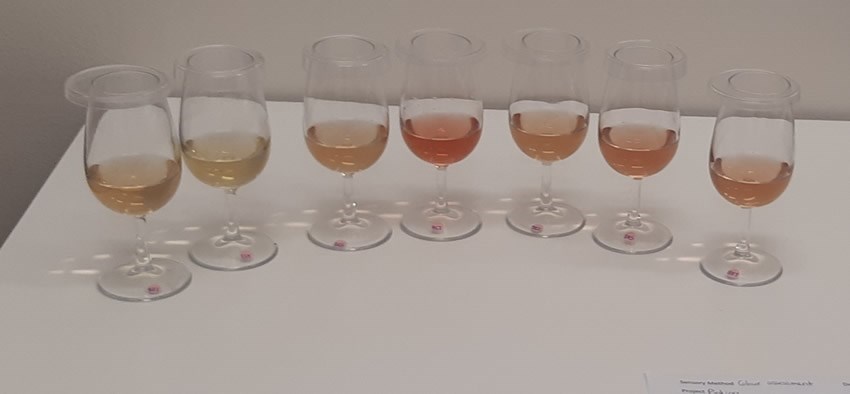In the process he conducted the first ever sensory analyses worldwide on the taste and aroma profiles of pinked white wines.
Dr Nel has been a lecturer in oenology since 2014 at the Cape Peninsula University of Technology’s Department of Agriculture on its Wellington campus. He picked up teaching experience at the Elsenburg Agricultural College, and found his feet in the wine world by working for the likes of KWV, Distell and various local wineries.
Dr Nel matriculated from Adamantia High School in Kimberley in 1987. After completing his mandatory army training, he started off in 1990 at KWV’s grape concentration plant in Robertson in their wine laboratory, and received basic training on wine analysis techniques at KWV’s headquarters in Paarl. He then moved on to the then Louwshoek-Voorsorg wine cellar (today Daschbosch) in Rawsonville, where as a harvest hand he did everything from cleaning wine tanks to assisting with wine filtration.
“Somewhere along the line I realised that if I have a bunch of grapes in my one hand and a bottle of wine in my other hand, I can manipulate the process in between. The idea fascinated me immensely,” he summarises how he became interested in winemaking per se.
He is still thankful for the opportunities that people like Jaco Potgieter, previous winemaker at Louwshoek-Voorsorg and today head winemaker at DGB Wellington, gave him along the way, despite him having very little experience and no official “papers” qualifying him as a winemaker.
Dr Nel went on to work in cellars in Montagu and Oudtshoorn – not only as winemaker but also as a brandy distiller – before returning to Rawsonville.
By 2004 he had already been married for seven years, and was the father of a three-year-old son when he enrolled as a first year student in viticulture and oenology at Stellenbosch University. At 34 years of age, he was much older than most in his class.
Today he is very thankful for the support that his wife, Helma, and children Pieter and Hesmarie have provided him along his academic journey.
“By the time I received my first degree, I decided that I wanted to learn everything that a university has to offer,” he remembers.
Dr Nel therefore continued his studies at SU – first completing his MSc in Oenology in 2010, and in 2021 also his PhD – all while working full-time too.
He conducted his PhD research under supervision of Dr Francois van Jaarsveld of the Agricultural Research Council (ARC) and Prof Wessel du Toit of the SU Department of Viticulture and Oenology. His studies were funded by Winetech as part of a project on pinking that was managed by the ARC.
Unwanted pinking
Dr Nel notes that the unwanted pinking of white wine is not the same as making rosé wines.
He completed his studies on Sauvignon blanc – a wine grape that fares better under cooler conditions. In the process he investigated viticultural and winemaking practices, and noted when pinking tended to occur most.
To do so, he first had to make his own pinked wine. During the course of 11 different experiments, he made at least 3000 litres of wine from 5 tons of grapes. Once, a gas bottle exploded, and he was left with glass shards in his leg – on Valentine’s Day, of all days!
To prevent pinking from occurring, winemakers have over the years learnt to pro-actively add chemicals such as polyvinylpolypyrrolidone (PVPP) as soon as the fermentation process is completed.
Through his studies Dr Nel realised that other chemicals such as ascorbic acid (added very early in the winemaking process) and vegetable proteins provide alternative options. Each one of these however come with their own issues, which then has to be handled in the cellar.
Therefore, Dr Nel believes that it is much better to use the correct viticultural and harvesting practices to sidestep the issue of pinking, rather than using additional chemicals to try and save a batch of faulty wine.
Temperature and the ripeness of grapes play a major role.
“The cooler a region, for instance as what is experienced in more mountainous regions, and the riper the grapes, the greater the chances that pinking will occur,” he notes.
“Don’t harvest in the middle of the night if temperatures are too cool.
Reductive winemaking increases the chance of pinking susceptibility in Sauvignon blanc wines.
Dr Nel also investigated the chemicals involved in the pinking process.
“It seems to be the colour molecule petunidin, but we are still unsure how exactly it causes pinking,” he explains. “Studies in Portugal have noted that the causative compound is more likely to be malvidin, which is part of the anthocyanin family.”

Pinking
Sensory tests
He used a trained panel of wine tasters to help him in the sensory analysis of pinked wines – the first of its kind to be done in the world on such wines.
The analyses showed that only 50% of the tasters could correctly identify the pinked wine on aroma alone, but not on taste.
“When they did pick up that something was wrong, they incorrectly identified it as being caused by oxidation, rather than by pinking,” Dr Nel notes.
He therefore believes that one would be able to create a market for pinked wines – an option being considered by winemakers in Italy, for instance.
Patent
Through the course of his research, Dr Nel developed a new type of closed system filter that can be used to filter wine samples reductively for laboratory purposes. It prevents oxidation of wines whenever the analyses of oxidative sensitive compounds are necessary.
The filter is in the process of being patented.
This winemaker with a passion for knowledge says he’d still like to find out if specific clones and rootstock have any influence on the development of pinking – but that’s a topic for another day!